
an impressive indoor vertical garden
Your Apartment Wall: The Next Generation Salad Bar
If you’ve ever looked at your apartment walls and thought, “Well, that’s a waste of perfectly good growing space,” you’re about to become your landlord’s worst nightmare – in the best possible way, of course. Welcome to the world of vertical salad gardening, where your security deposit meets photosynthesis, and your walls become a produce section.
The Real Estate Your Plants Need
Before you start hammering into walls with the enthusiasm of a caffeinated woodpecker, let’s talk about location. Your vertical garden needs light – and lots of it. South-facing walls are the garden apartment equivalent of beachfront property. East and west exposures are like the nice suburbs – they’ll do just fine. North-facing walls? That’s the sketchy part of town where leafy greens go to die. If you’re stuck with northern exposure, you’ll need to supplement with grow lights, or resign yourself to growing mushrooms (but that’s a different article entirely).

tropical plant indoor vertical garden
The Great Wall Decision
Now comes the million-dollar question: how to mount your garden without turning your security deposit into a donation. Command strips and removable hooks are your new best friends. But here’s the catch – they need to be rated for the weight of your system when it’s fully loaded with wet soil and plants. That cute little plastic planter might only weigh a pound now, but add soil, water, and a fully grown lettuce plant, and suddenly it’s heavy enough to become a landlord’s nightmare.
For a basic setup that won’t send your wall crashing into your neighbor’s living room, you’ve got several options. Pocket planters (think over-the-door shoe organizers but for plants) are perfect for lettuce and herbs. Gutters mounted with heavy-duty command strips work beautifully for shallow-rooted greens. And for the commitment-phobes, a rolling baker’s rack positioned against the wall gives you vertical growing space without the wall attachment anxiety.
Soil Is Not Just Dirt, People
Here’s where most vertical gardeners face-plant right into failure: they use regular potting soil. That’s like trying to run a marathon in flip-flops – technically possible, but why make life harder? You need a lightweight, water-retaining mix that won’t compress over time and turn into a brick. Mix equal parts high-quality potting soil, perlite, and coconut coir. Add a handful of vermiculite for water retention, and you’ve got the perfect vertical garden mix. And please, for the love of all things green, don’t forget to add Mittleider nutrients to this mix – your plants will reward you with growth that would make Jack’s beanstalk jealous.
The Water Situation
Gravity is not your friend in vertical gardening – it’s that party guest who shows up uninvited and makes everything awkward. Water will always want to flow downward, potentially creating a waterfall effect that would make Niagara Falls proud (and your downstairs neighbors very unhappy). The solution? A drip irrigation system with catch trays isn’t just fancy – it’s essential. Set up a simple system using aquarium tubing and drip emitters, or go full tech with a programmable watering system. Either way, make sure you have something to catch the excess water, unless you’re trying to create an indoor water feature (spoiler alert: you’re not).

potting soil, perlite, and coconut coir mix for planting indoors
Plant Selection: Not All Heroes Wear Leaves
Let’s talk about what to grow. Lettuce, spinach, and other leafy greens are your vertical garden MVPs – they’re lightweight, quick-growing, and shallow-rooted. Herbs like basil, cilantro, and parsley are also excellent choices. But before you get carried away and try to grow pumpkins up your wall (please don’t), remember this golden rule: if it fruits, it probably doesn’t belong in your vertical salad bar. Stick to leaves, and you’ll be swimming in salads before you know it.
The Maintenance Dance
Your vertical garden isn’t a set-it-and-forget-it situation (unless your goal is to create abstract wall art with dead plants). Check your plants daily for watering needs – stick your finger in the soil like you’re testing a cake. Yellow leaves at the bottom? Normal. Yellow leaves everywhere? You’ve got problems. Rotate your containers if they’re getting uneven light, and harvest outer leaves regularly to encourage new growth. And for heaven’s sake, keep an eye on those mounting solutions – nobody wants their garden to suddenly relocate to the floor.
Pest Control in the Urban Jungle
Just because you’re growing indoors doesn’t mean you’re safe from pests. Aphids, spider mites, and other tiny terrorists can still find your garden. The good news? You can control most issues with a spray bottle filled with water and a few drops of dish soap. If that doesn’t work, neem oil is your nuclear option. Just don’t spray anything you plan to eat in the next 24 hours, unless you enjoy your salad with a side of soap flavor.
Remember, your vertical salad bar is a marathon, not a sprint. Start small, learn from your inevitable mistakes (we all kill plants sometimes), and before you know it, you’ll be eating the freshest salads in your apartment building. Just don’t forget to invite your landlord over for dinner – they might be more forgiving about those wall mounted planters when they taste your homegrown lettuce.
The Final Harvest
With proper planning, the right setup, and a bit of patience, your walls can become a productive growing space that would make any restaurant’s salad bar jealous. Just remember: start small, build up gradually, and always, always make sure your mounting system can handle the weight. Your future self (and your security deposit) will thank you.


